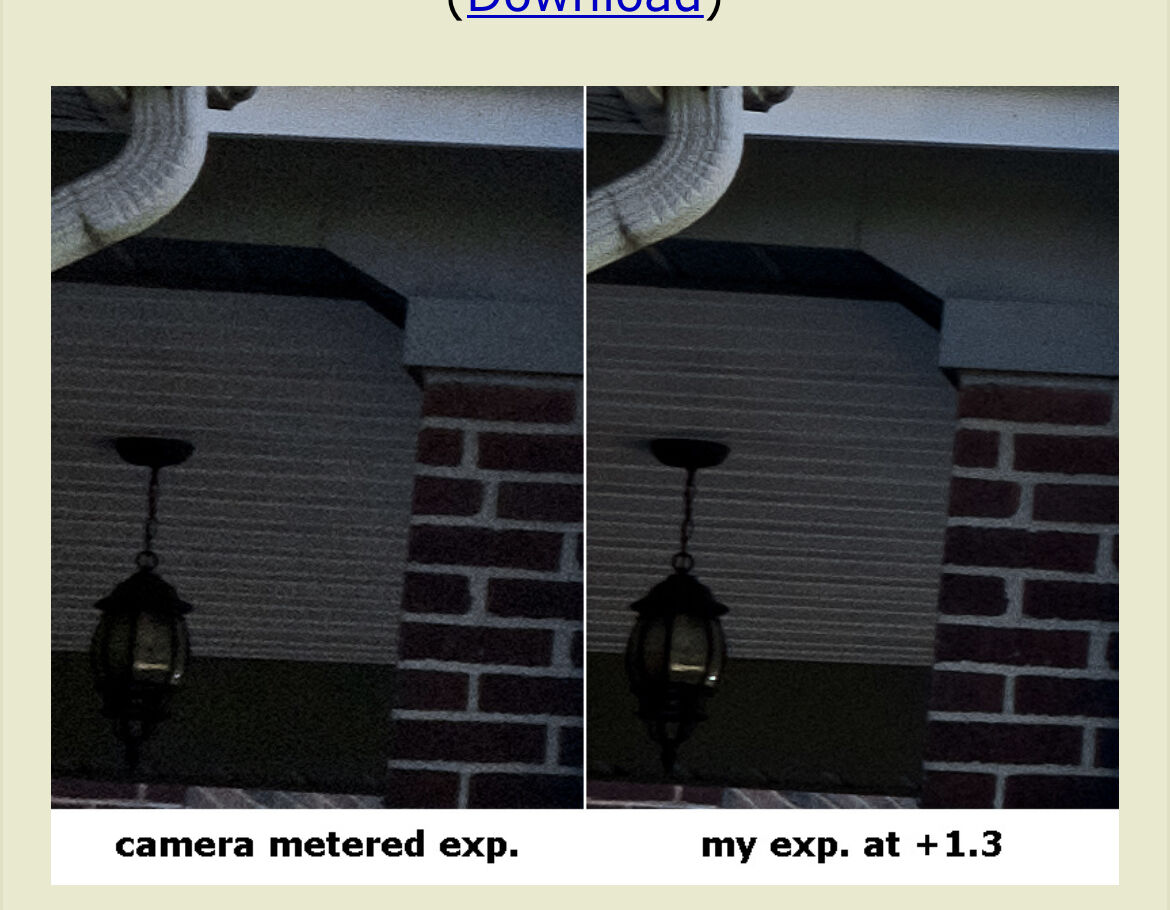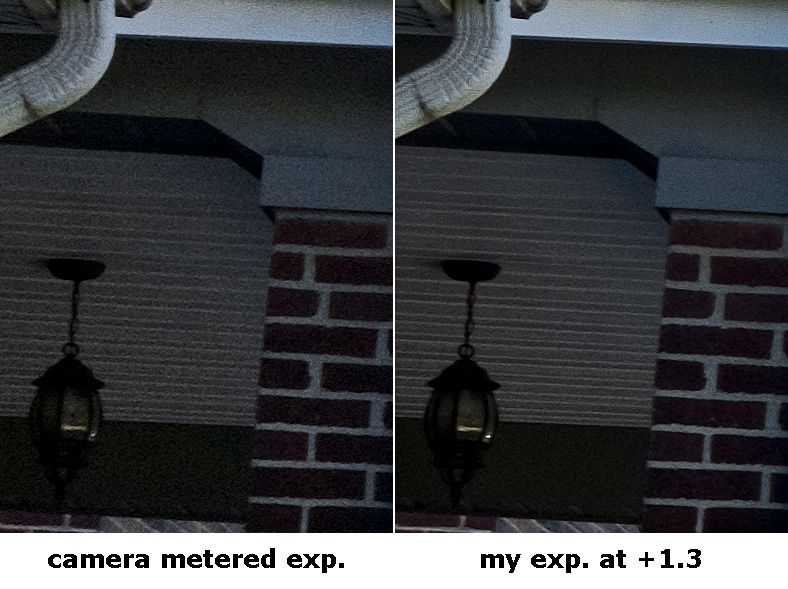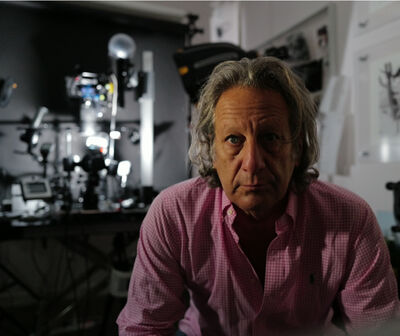What does ETTR accomplish?
Sep 24, 2022 22:15:46 #
Ysarex
Loc: St. Louis
Longshadow wrote:
Not in the slightest.
That's why a friend of mine spent two weeks sanding the wood floor in his living room. He wanted it to be as good as possible.
That's why a friend of mine spent two weeks sanding the wood floor in his living room. He wanted it to be as good as possible.
Trifles make perfection, and perfection is no trifle. --Michelangelo
Sep 25, 2022 02:22:21 #
Ysarex wrote:
Here's a photo I just took in broad daylight. First image below you see the camera SOOC JPEG (1/2 res for display) -- exposure was metered and set by the camera (base ISO - 125, f/5.6, 1/640 sec. EC = 0).
You shouldn't be surprised about the amount of noise from your Canon PowerShot. It doesn't have much DR in its tiny sensor.

A decent camera can do better with Sunny 16 at ISO 400 than your point and shoot at ISO 125.
Try that shot with a better camera and you won't have much noise, if any.
Ysarex wrote:
Is there something wrong with as good as possible? Especially since it's not a tradeoff with a down side.
Yes, there is a downside. It takes more effort to use ETTR.
Sunny 16 lets you shoot without having to fiddle with exposure at all.
And you can adjust the exposure for a camera with Zebra warnings while you are framing the shot - hardly any effort at all.
Or we can just follow the camera's exposure recommendation and look for blinkies in the result. If we see them, adjust the exposure and try again.
If I had any reservations about the noise in any of my shots I would have used ISO 100 instead of ISO 400. That would have called for two stops of additional exposure. But this wasn't necessary because there wasn't any noise visible in the images.
On the other hand, the shutter speed at ISO and f/8 would still have been high enough to hand-hold the cameras with the lenses that were used - a 35mm 35mm Tamron with VC in the lens on the Df and a 55mm lens on the Sony with IBIS.
Sep 25, 2022 02:24:19 #
Ysarex wrote:
Trifles make perfection, and perfection is no trifle. --Michelangelo
Obsessing over trifles is a waste of time.
Sep 25, 2022 04:05:11 #
selmslie wrote:
On the other hand, the shutter speed at ISO and f/8 …
At ISO 100 and f/8.
Sep 25, 2022 05:52:19 #
Sep 25, 2022 06:11:27 #
Ysarex wrote:
....in those cases a stop more exposure definitely makes a visible difference.
You can add to that the fact that lifting the shadows is just one of the editing processes that aggravate noise. The more pushing and pulling you have to do in PP, the bigger a difference that extra stop will make. And we don't all have the luxury of owning the newest and best cameras that don't have much of a noise problem in the first place.
Sep 25, 2022 06:53:41 #
R.G. wrote:
You can add to that the fact that lifting the shadows is just one of the editing processes that aggravate noise. The more pushing and pulling you have to do in PP, the bigger a difference that extra stop will make. And we don't all have the luxury of owning the newest and best cameras that don't have much of a noise problem in the first place.
There is no question about the underlying logic of ETTR - that additional exposure will record less noise in the shadows. This is true no matter how much you have spent on your camera.
The problem is that we have to go to unreasonable lengths to demonstrate this phenomenon. There are a couple of factors that seldom come up but they are the gorilla in the room.
The first is that a scene with a narrow dynamic range (DR), less than 6 or 7 stops, does not need meticulous exposure. The brightest part of the scene will not come close to the raw upper limit and the darkest part of the scene is not dark enough to show noise so long as you follow the meter's recommendation and are not using an unreasonably high ISO.
The second is that a scene with a very wide DR and correctly metered by the camera will already have the brightest part of the image very close to the raw limit leaving little or no room to increase exposure. The only remedy in this case is to use the cameras widest DR, base ISO.
But even when we capture a scene with a wide DR with a camera that has a narrow DR at base ISO, it's almost impossible to see the benefit of about one stop of additional exposure. You are forced to search for the noise in a tiny portion of the image and enlarge it beyond 100%.
Sep 25, 2022 07:02:15 #
Here's something that doesn't happen every day:
It's where it probably belonged in the first place but since I placed an image in the initial post I assumed it would have gotten moved to the gallery.
an automated notice. wrote:
"Your topic "What does ETTR accomplish?" was moved
from "Photo Gallery" section
to "Main Photography Discussion" section.
from "Photo Gallery" section
to "Main Photography Discussion" section.
It's where it probably belonged in the first place but since I placed an image in the initial post I assumed it would have gotten moved to the gallery.
Sep 25, 2022 08:12:21 #
selmslie wrote:
Here's something that doesn't happen every day:
It's where it probably belonged in the first place but since I placed an image in the initial post I assumed it would have gotten moved to the gallery.
It's where it probably belonged in the first place but since I placed an image in the initial post I assumed it would have gotten moved to the gallery.
Thank you for doing the testing, providing detailed well thought-out examples, and leading a very logical discussion.
This thread exercises my brain and gives me Constructive items to think about.
As far as the "Gallery vs Main Photography Discussion" goes, sometimes things correct themselves, and that makes me . . . .
Smile,
JimmyT Sends
Bravo Zulu





Sep 25, 2022 08:14:08 #
selmslie wrote:
Obsessing over trifles is a waste of time.

Sep 25, 2022 08:23:38 #
selmslie wrote:
....You are forced to search for the noise in a tiny portion of the image and enlarge it beyond 100%.
That may be true for SOOC, but what if you want to brighten those parts of the image and add contrast and sharpening on top of that (maybe Clarity as well).
And if the scene consists of small, bright highlights that you want to save set against a dark background that you want to brighten etc, the potentially problematic areas won't be just small corners here and there.
I agree with you when you suggest it's predictable that the SOOC image is not going to benefit much from ETTR, but on the other hand you can't always predict how much PP an image is going to need, or what kind of extreme adjustments it'll need. And when it comes to editing scenes with a low DR, I would rather have to darken them than brighten them (either wholly or in part).
Sep 25, 2022 09:10:53 #
Ysarex wrote:
Absolutely, and I encounter it often enough. br b... (show quote)
This is why I ETTR. If this image was compensated to brighten during capture, the noise would have been significantly lessened than lightening in post.

Sep 25, 2022 09:30:18 #
R.G. wrote:
That may be true for SOOC, but what if you want to brighten those parts of the image and add contrast and sharpening on top of that (maybe Clarity as well).
I was not referring to the SOOC image.
I was talking about the image that Robertl594 just cited as the reason he used ETTR. That comparison was between two images 1.3 stops apart and developed from raw to recover the shadows.
R.G. wrote:
And if the scene consists of small, bright highlights that you want to save set against a dark background that you want to brighten etc, the potentially problematic areas won't be just small corners here and there.
Are you referring to an image that might have bright flowers against a dark background. Why would you want to ruin an image like that?
Sep 25, 2022 09:41:02 #
selmslie wrote:
Are you referring to an image that might have bright flowers against a dark background. ...?
No.
Sep 25, 2022 09:43:58 #
Ysarex
Loc: St. Louis
selmslie wrote:
You shouldn't be surprised about the amount of noise from your Canon PowerShot. It doesn't have much DR in its tiny sensor.
All the more reason then to use what is available to full advantage.
selmslie wrote:
A decent camera can do better with Sunny 16 at ISO 400 than your point and shoot at ISO 125.
Try that shot with a better camera and you won't have much noise, if any.
Try that shot with a better camera and you won't have much noise, if any.
So now that you've been proven wrong you're going to start back peddling to qualify your mistaken claim by saying you were only referring to decent cameras? One reason some people use ETTR is to bolster the results from smaller sensor cameras. You don't dictate everyone's photographic practice.
selmslie wrote:
Yes, there is a downside. It takes more effort to use ETTR.
Only if you're extraordinarily lazy; "I know I could turn the EC dial but it's sooooo hard."
selmslie wrote:
If I had any reservations about the noise in any of my shots I would have used ISO 100 instead of ISO 400. That would have called for two stops of additional exposure. But this wasn't necessary because there wasn't any noise visible in the images.
Just because you took some photos in which visible noise wasn't an issue doesn't mean that those examples apply to all the photos taken by everyone. They don't. You don't dictate everyone's photographic practice.
You said: "I cannot conceive of a case where one stop of additional exposure can produce enough of a change in SNR for it to be seen." And now you're proven wrong with visible evidence.

If you want to reply, then register here. Registration is free and your account is created instantly, so you can post right away.




